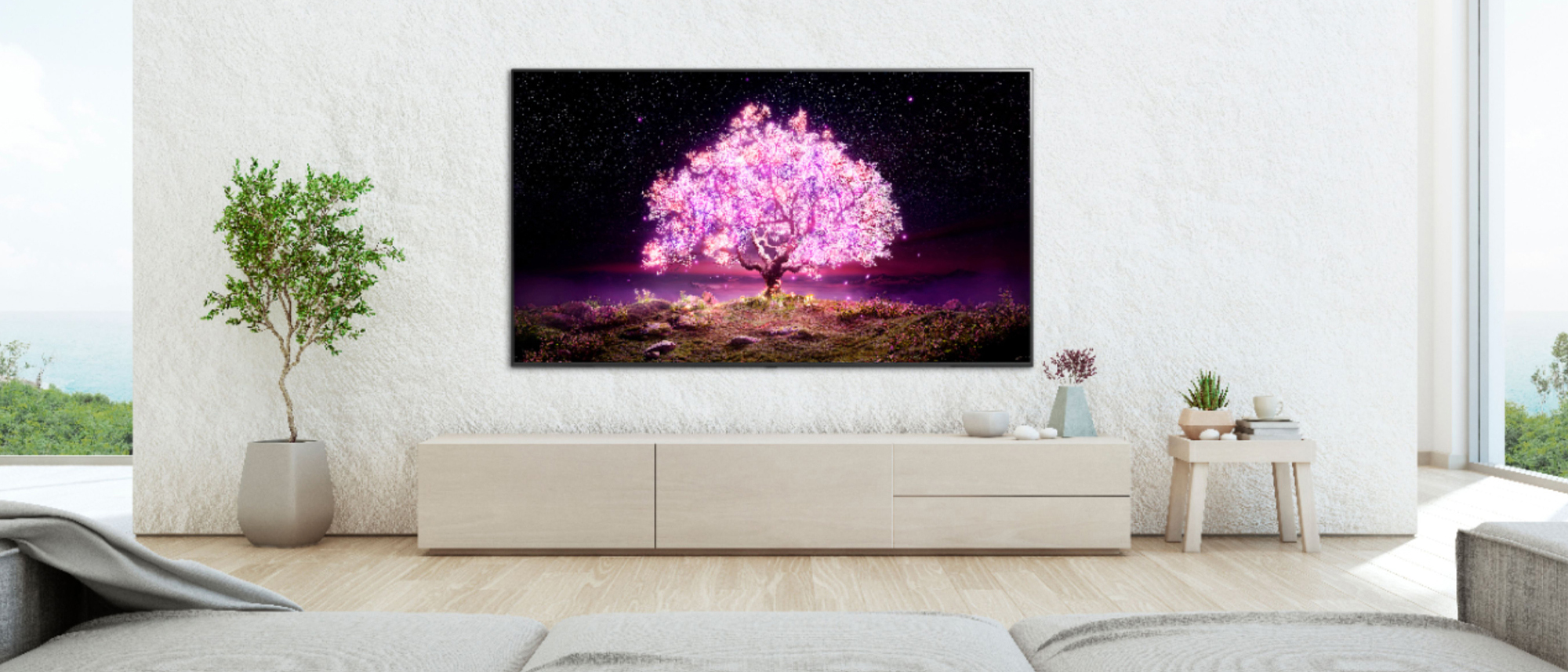Tom's Guide Verdict
Although there's a newer model available, the LG C1 OLED is one of the best TVs you can buy, and definitely the best choice for gamers. In almost every respect, it delivers exactly what you expect from a premium OLED TV.
Pros
- +
Fantastic picture quality
- +
Future-proof HDMI 2.1 ports
- +
Best-in-class gaming performance
Cons
- -
webOS is missing some apps
- -
Sound quality needs tweaking
Why you can trust Tom's Guide
Price: $1,499
Model number: OLED55C1PUB
Screen size: 55 inches
Resolution: 3,840 x 2,160
HDR: Dolby Vision, HDR10, HLG
Refresh rate: 120 Hz
Ports: 4 HDMI 2.1 (1 with eARC), 3 USB
Audio: 40W, 2.2 channel sound
Smart TV software: webOS
Size: 48.3 x 27.8 x 1.8 inches (w/o stand)
Weight: 41.7 pounds (w/o stand)
The LG C1 OLED, released in 2021, continues to be one of the best TVs you can buy, despite being a year old at this point. Age hasn't slowed it down a bit and, thanks to retailers trying to make room on the shelf for the newer LG C2 OLED models, you can now find the LG C1 OLED at a significantly lower price than when it launched.
To that end, the LG C1 OLED is more affordable than the premium LG G1 OLED and more capable than the budget-friendly LG A1 OLED that grabbed so much attention over Black Friday. The result is one of the best OLED TVs we've seen all year, and easily the best gaming TV you can buy today.
With great performance, a number of welcome improvements to the feature set and interface, and some of the best future-proofing of any 4K smart TV, the LG C1 OLED is one of the top TVs on the market. Plus with Samsung's cheaper OLEDs now indefinitely delayed, the LG C1 is still your best inexpensive OLED TV available.
Not sure if you should upgrade to the C2 or stick with the C1? Our guide to the LG C2 vs. LG C1 OLED TV to help you decide whether you should get the C1 on sale or splurge for the newer model.
LG C1 OLED: Price and availability
LG's OLED TVs are available in a larger range of sizes than ever before, and the C1 OLED boasts the full range of options for a 4K OLED, starting with a compact 48-inch model all the way up to a giant 83-inch set that will be far too large for most homes, but is perfect for a big home theater. If you need help figuring out which version is right for you, be sure to see our guide What size TV should you buy?
We've listed the current regular retail prices below, but sales prices are making these TVs more affordable than ever – that's why we bought it ourselves. This end of the year period is also the best time to be shopping for these sets, because the prices are at their lowest point all year, but they fluctuate quite a bit as major sales events like Black Friday start and finish, and prices drop in anticipation of new models being announced in January. (Speaking of the new models, we've got an LG C2 vs LG C1 OLED TV comparison to help you decide which model to buy.) Whenever you're after a lower price, it's worth looking at our LG promo codes page to see if there are any savings available right now.
- 48-inch (Model OLED48C1PUB) — $1,299.99
- 55-inch (Model OLED55C1PUB) — $1,499.99
- 65-inch (Model OLED65C1PUB) — $2,099.99
- 77-inch (Model OLED77C1PUB) — $3,299.99
- 83-inch (Model OLED83C1PUA) — $5,499.99
For this review, we tested the 55-inch model. Because these sets vary in size, but are otherwise identical in terms of software, ports and features, we have no doubt that our recommendations will apply to all sizes, with no significant differences between them. You'll get the same great performance and features on models large and small.
LG C1 OLED: Design
The LG C1 uses a design that should be familiar, since the C series look is pretty much unchanged over the last several years. It's the same design we saw in our LG CX OLED review in 2020, and the LG C9 OLED before that.
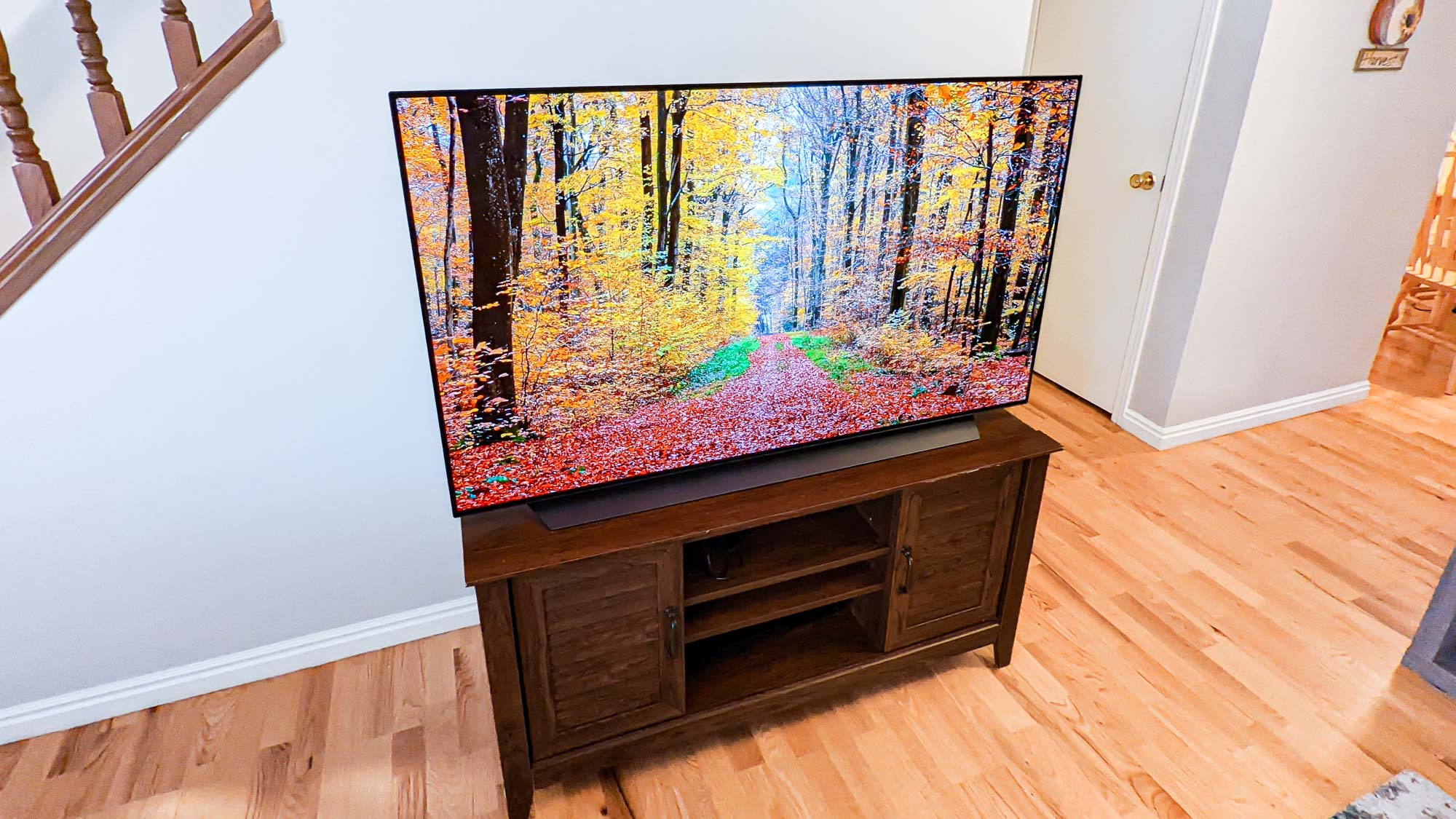
But that's not a bad thing at all — the look is still stunning, thanks to the unbelievably thin dimensions of OLED displays and LG's display-on-glass design. It's dramatically thinner than any other premium TV, like the Samsung QN90A Neo QLED TV, which measures a respectable 1-inch thick. Through the entire top half of the TV, the LG C1 measures 0.1-inch thick. There's just no competing with that in terms of a polished, nearly futuristic look.
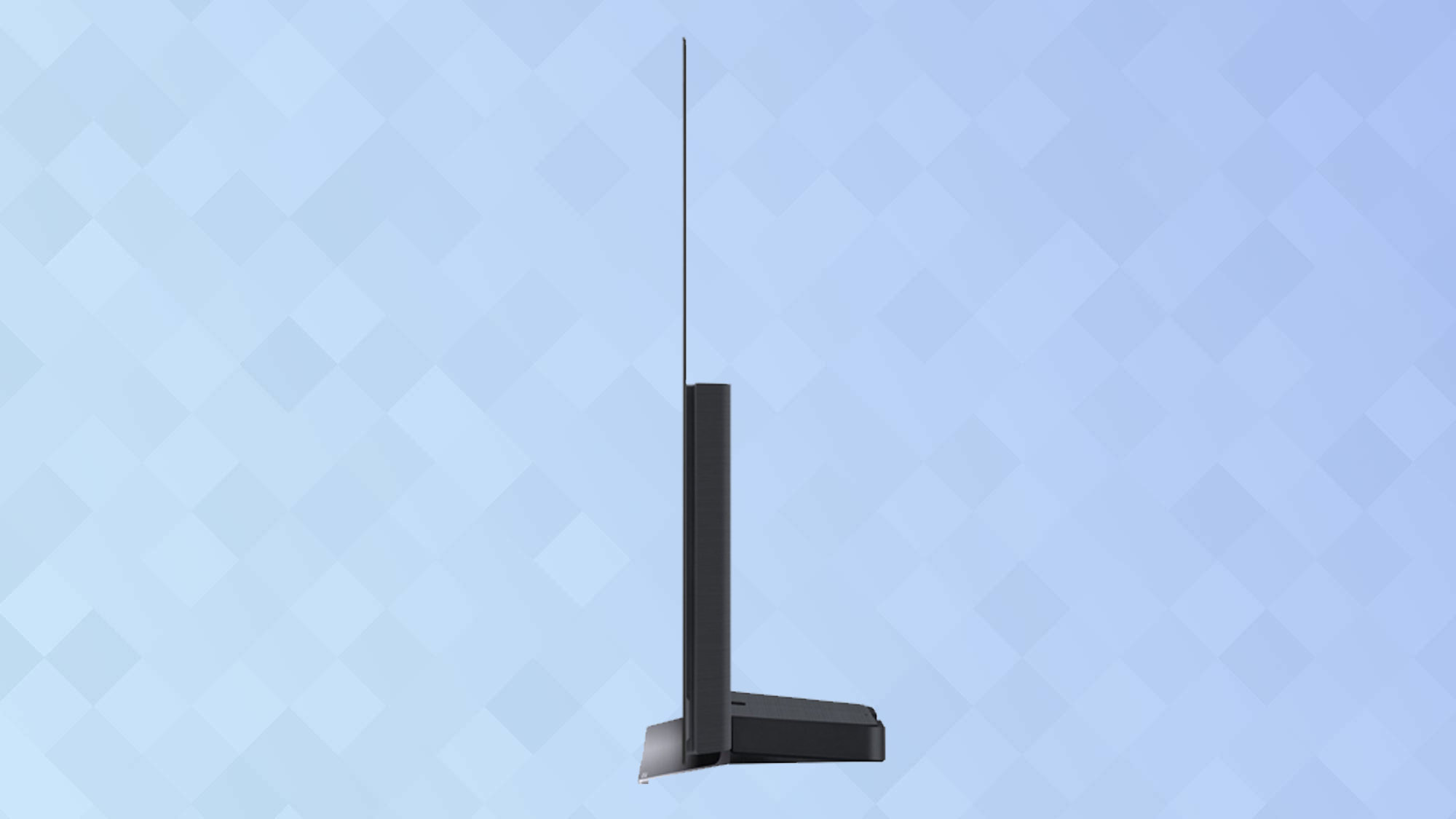
There's just no competing with the LG C1 OLED in terms of a polished, nearly futuristic look.
With a thicker component housing on the bottom half of the TV, the TV's overall dimensions are 48.3 x 27.8 x 1.8 inches, and the chunk base of the stand has a footprint that's 9.9 inches deep. It's not super heavy at 41.7 pounds, but you definitely want two people to help set this up, even at the smaller 55-inch size. The thin and slightly flexible panel of the all-glass display is hard to maneuver solo.
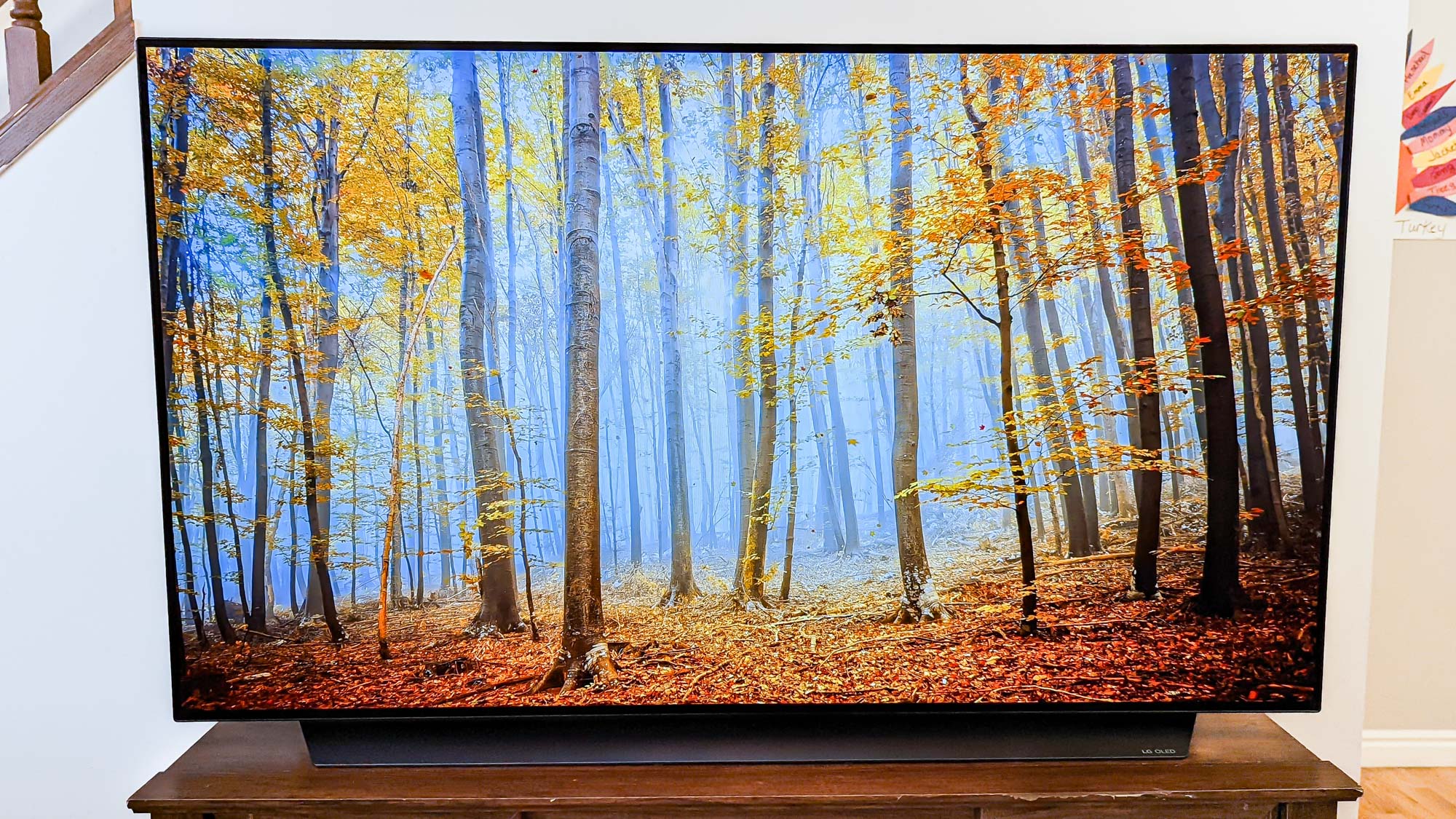
The pedestal stand that comes with the LG C1 is great, but if you want to wall mount the set, it will work with any 300 x 200 millimeter VESA mount, including several models on our list of the best TV mounts.
LG C1 OLED: Ports
On the back of the TV there are two panels of ports and connections, one rear-facing and one left facing. The rear-facing panel includes one HDMI input and two USB connections along with coax, ethernet, a headphone jack for audio, a headphone style service port, and a digital optical audio output.
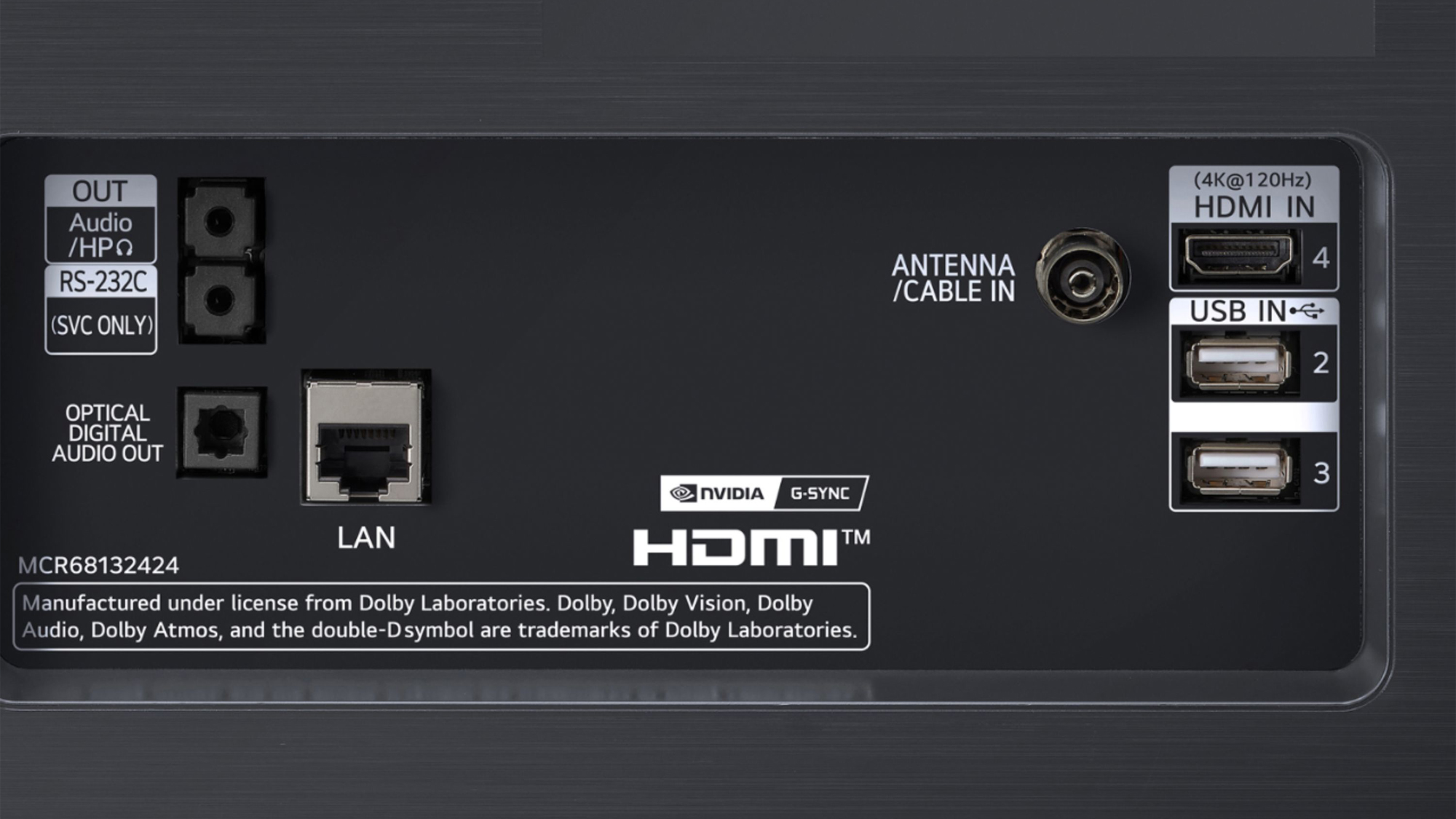
On the left-facing panel there are three HDMI 2.1 ports ( one with eARC), and a single USB input. For wireless connectivity, the TV also has built-in 802.11ac and Bluetooth 5.0.
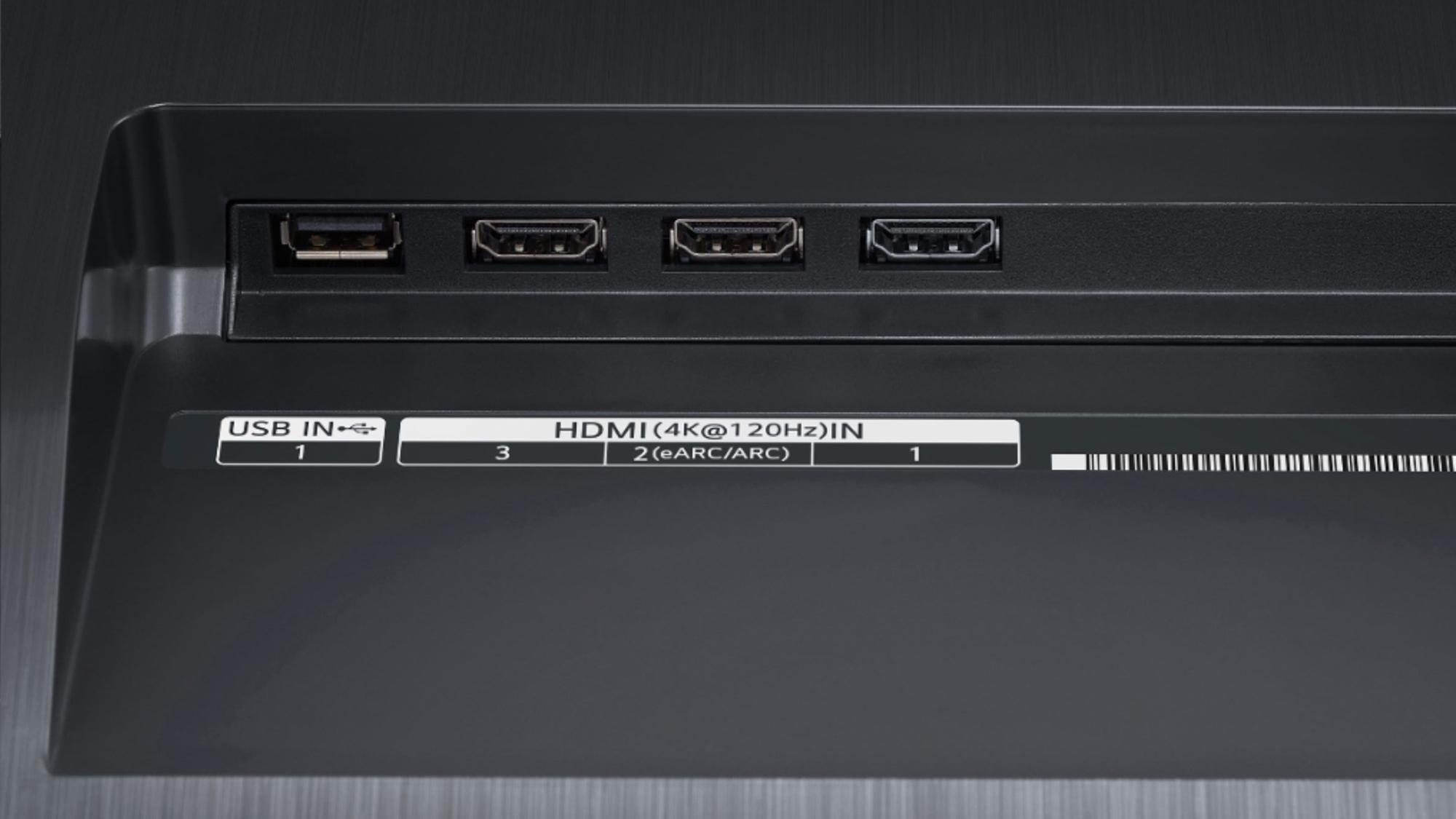
The fact that the C1 boasts HDMI 2.1 connectivity on all four of its HDMI ports puts it head and shoulders above the competition, offering advanced capabilities like high frame rate gaming and 4K content at 120Hz. If you have one of the latest game consoles, that's a huge selling point.
LG C1 OLED: Performance
We expected great picture quality from the C1 by virtue of its OLED display panel. OLED technology offers self-illuminated pixels, with the ability to brighten or darken individual pixels, which translates into exceptional contrast, perfect inky black levels and superior HDR capability. But LG goes a step further, pairing this display with the Alpha 9 Gen 4 AI 4K processor, the latest version of LG's advanced video processing hardware.

Basic performance tests showed us what we already expected with the OLED display. Veiwing angles are excellent, with no color shifting even at extreme viewing angles, and perfectly consistent backlight. Unlike even the best LCD TVs, that meant the C1 produced perfectly consistent brightness from corner to corner and edge to edge, which is in keeping with the per-pixel lighting that OLED offers.
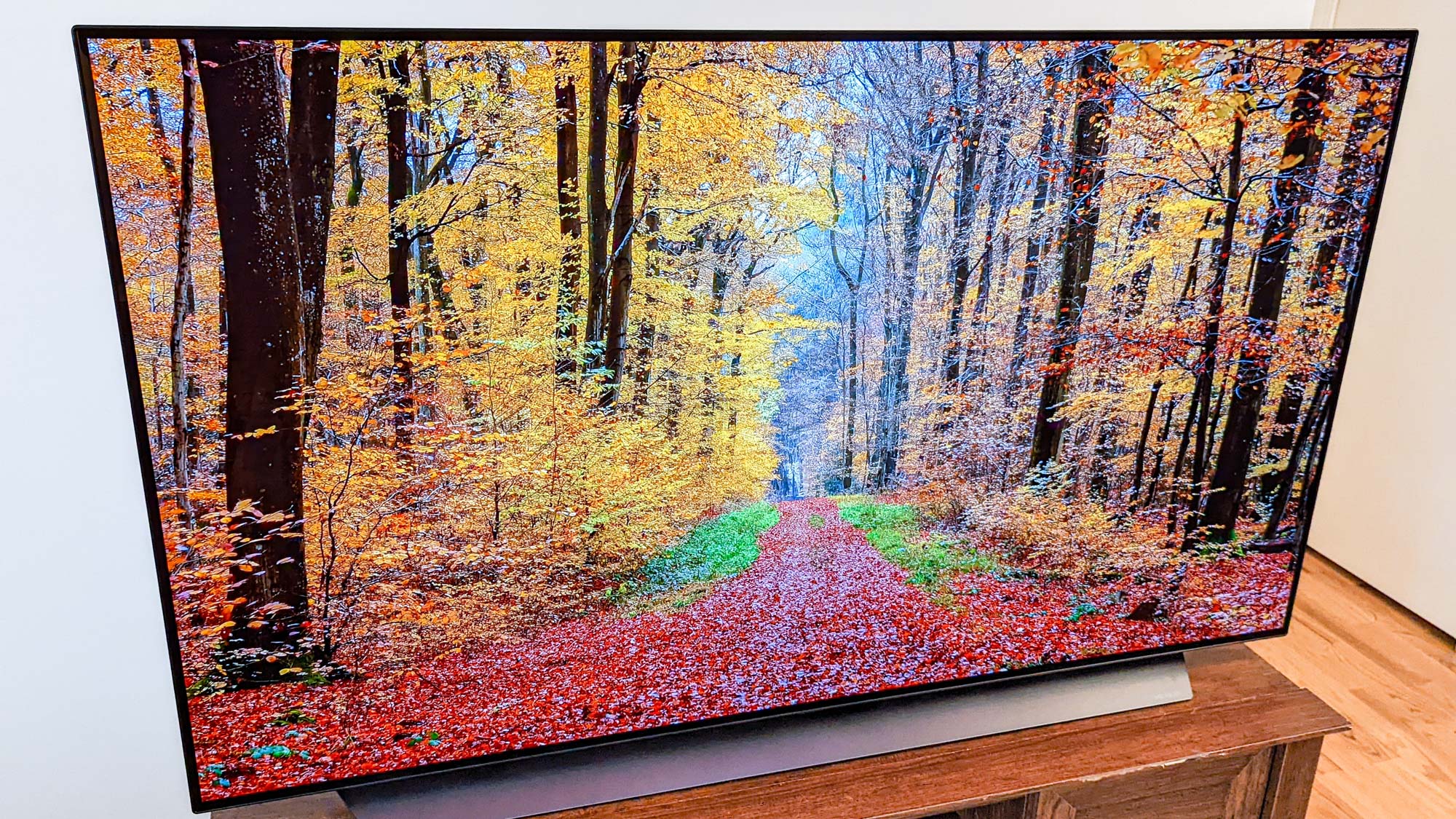
Watching select 4K samples really drove home the quality of the UHD display. An aerial tour of the coast of Italy showed craggy cliffs and tiny windowed buildings – all small enough to look like miniatures, but with itsy-bitsy cars on the roads and boats floating in the ocean. The blue waters of the ocean were vibrant, the green vegetation was lush, and the cliffside buildings all looked beautiful.
Another 4K video of drone footage of Manhattan gave us sharp, detailed views of the Statue of Liberty, as well as various landmarks in and around Manhattan. Blue skies look blue, brightly buildings glowed realistically at night, and shots of the Brooklyn Bridge had realistically detailed brick and high tension wires. It all looked really good.
Watching the 4K trailer for The Matrix Resurrections, the vibrant colors all came through bright and life-like, if not a little over-amped and saturated to provide an intentional, unrealistic visual effect. The nearly hallucinogenic imagery looked great on the OLED display, from bright blue pills in the sink to brightly colored clothing and the familiar green matrix code.
LG C1 OLED: Test results
Once we got the C1 under the scope, the test results spoke to the excellent performance the OLED TV offers. Using an X-Rite i1 Pro spectrophotometer, an AccuPel DVG-5000 video test pattern generator and SpectraCal CalMAN Ultimate calibration software, we test every TV for the most basic elements of picture quality: Color gamut reproduction, color accuracy, and maximum brightness.
The hallucinogenic imagery in the The Matrix Resurrections trailer looked great on the OLED display, from bright blue pills in the sink to the green matrix code.
As expected for an OLED TV, the C1 has fantastic color, and reproduced 131.59% of the Rec 709 color gamut, exceeding the basic standard, much as we've seen in the Sony Bravia XR A80J OLED (128.05%) and the LG G1 OLED TV (133.28%). That's common in OLED displays, which routinely beat out even the best LCD TVs, like the Samsung QN90A Neo QLED, which is one of the best we've tested at 99.78%.
Color accuracy was also top-notch, with an average Delta-E rating of 1.25, where lower scores are better — 0 is a perfect score, but anything under 2.0 is considered very good for out of the box accuracy. That makes it one of the most accurate TVs we've ever seen, ahead of last year's LG CX OLED (1.95), or this year's LG G1 OLED (1.63) and Sony A80J (2.88), despite these TVs being some of the best we've seen. Even the best non-OLED TVs, like the Samsung QN90A (2.57) struggle to match this level of accuracy.
The TV also offers great brightness, which is one area where OLED displays have traditionally struggled. The LG C1 produced 409 nits of brightness, which is a slightly higher result than the 2020 LG CX OLED (396 nits) or the Vizio OLED TV (373 nits), and only slightly behind the LG G1 OLED (412 nits), which is one of the best results of any OLED TV and features LG's bolder and brighter OLED evo technology.
LG C1 OLED: Gaming
Gamers will also love the short 12.6 milliseconds of lag time that we measured in testing. That matches the impressive Samsung QN90A Neo QLED (12.6ms), and is one of the shortest lag times we've ever measured.
But that's only one of the many factors that makes the C1 OLED a fantastic gaming TV. LG has built up the gaming capabilities of the C1 significantly, from raw capability — short lag times, excellent color and contrast — to advanced features, like HDMI 2.1, which offers high-frame rate support and auto low-latency mode (ALLM), which seamlessly switches to gaming mode as soon as you fire up a game on your console.
Gamers will love the short 12.6 milliseconds of lag time that we measured, which is one of the shortest we've ever measured.
Another key feature of HDMI 2.1 is variable refresh rate (VRR), but LG takes it a step beyond with a combination of exclusive features. The LG C1 OLED boasts Nvidia G-Sync, making it ideal for PC gaming, and has also added support for Dolby Vision HDR at 120Hz, which is currently only offered on the Xbox Series X.
LG has also added a unique Game Optimizer menu, which gives you data about current frame rates and latency, and lets you adjust specific aspects of picture and processing such as black stabilizer, latency, VRR support and HDR settings.

With our Xbox Series X connected, we could see that the TV supports 4K UHD gameplay at 60 Hz and 120 Hz, along with HDR 10 and Dolby Vision. In regular movie and TV playback, the TV sports 10-bit color at 24, 50 and 60 Hz. If the Xbox supports it, the LG C1 OLED supports it as well.
And it all shows in actual gameplay. Getting a bird's-eye view in Assassin's Creed Valhalla, peering through the eyes of a raven, I was able to swoop over and around a highly detailed Norse village. The richly detailed world is full of vibrant colors, with decorative rooftops, realistic snowfall, and lots of birds flapping around. Back on ground level, interacting with other characters, I was pleased to see finely detailed fur and tooled leather, not to mention a great range of brightness thanks to HDR.
From the basic responsiveness and picture quality to the fine-tuned features and format support, this TV is built to deliver a premium gaming experience. The end result is one of the best gaming TVs we've ever seen.
LG C1 OLED: Audio
The LG C1 OLED offers sound that's just as premium as the display. Equipped with 40 watts of 2.2 channel audio, the slim TV boasts better-than-average sound and volume.
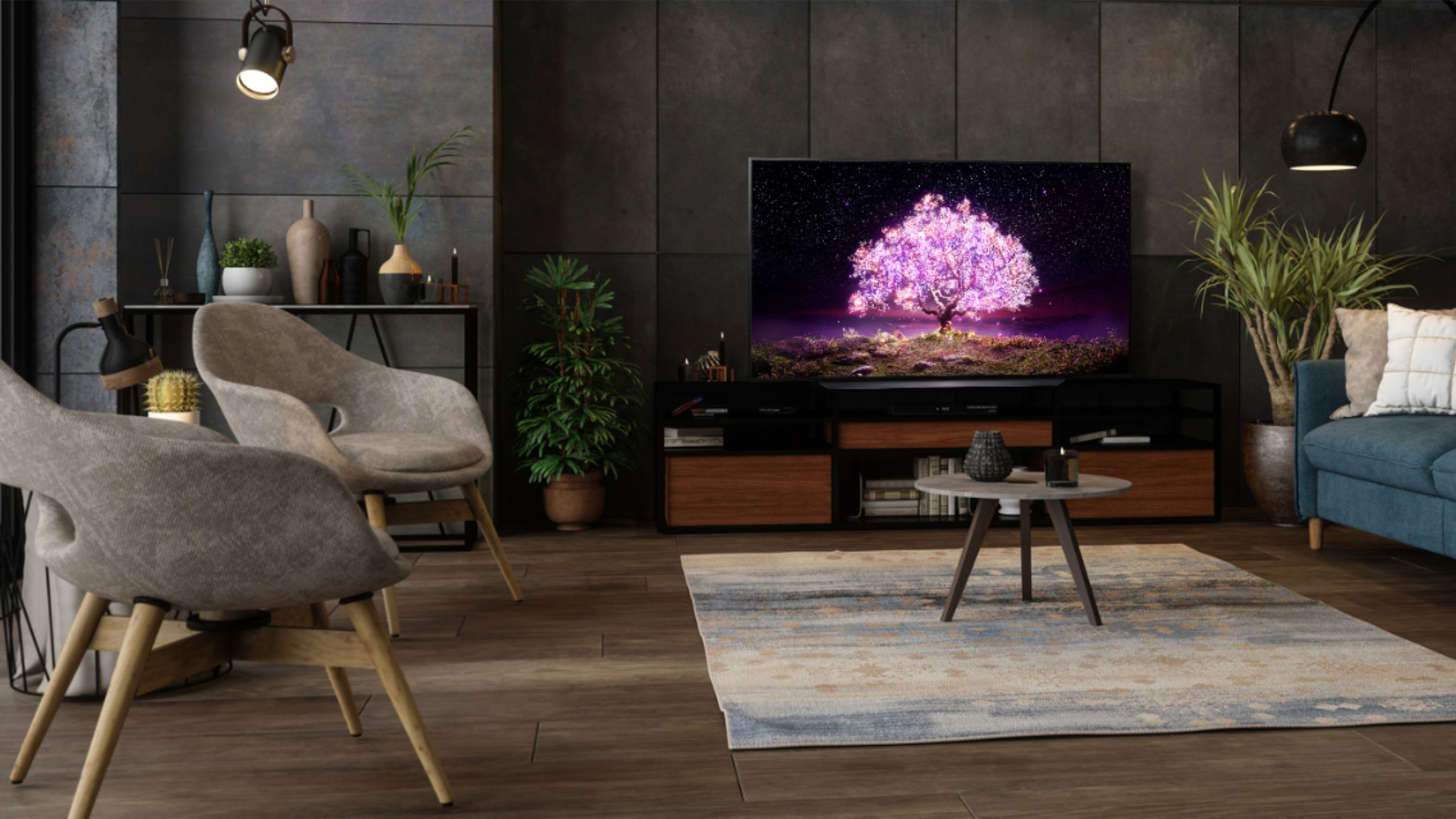
In my hands-on time with the TV, I was thrilled by the sound quality. When watching video, the accompanying dialog was clear and easy to understand. When listening to music from the new Netflix Cowboy Bebop soundtrack, I loved how well the TV brought out the funky kung-fu film-inspired bassline and conga drums in the track Blood Brothers, and the updated version of Tank! Was super clear when playing the blaring horns that might overwhelm the speakers on a lesser TV.
But even quieter sounds come through clearly. Watching a 4K fireplace video, the crackles and pops of burning logs were crisp and clear, while the low rumble of the fire came through realistically.
The one area where the TV didn't wow me was the bass quality. At volumes below 25%, the bass levels were lackluster, and too quiet to balance the rest of the sound. Conversely, when the volume was up higher, around 70%, bass not only got louder, it overpowered the treble more than it should. You could probably fix both of these issues in the equalizer settings, but the balance wasn't perfect under the default settings.
Related to sound, the LG C1 OLED also has some extra features that are a cut above. The TV's Bluetooth connectivity means that you can pair it with Bluetooth speakers for easy surround sound, and WiSA connectivity delivers wireless 5.1 for WiSA-ready sound systems.
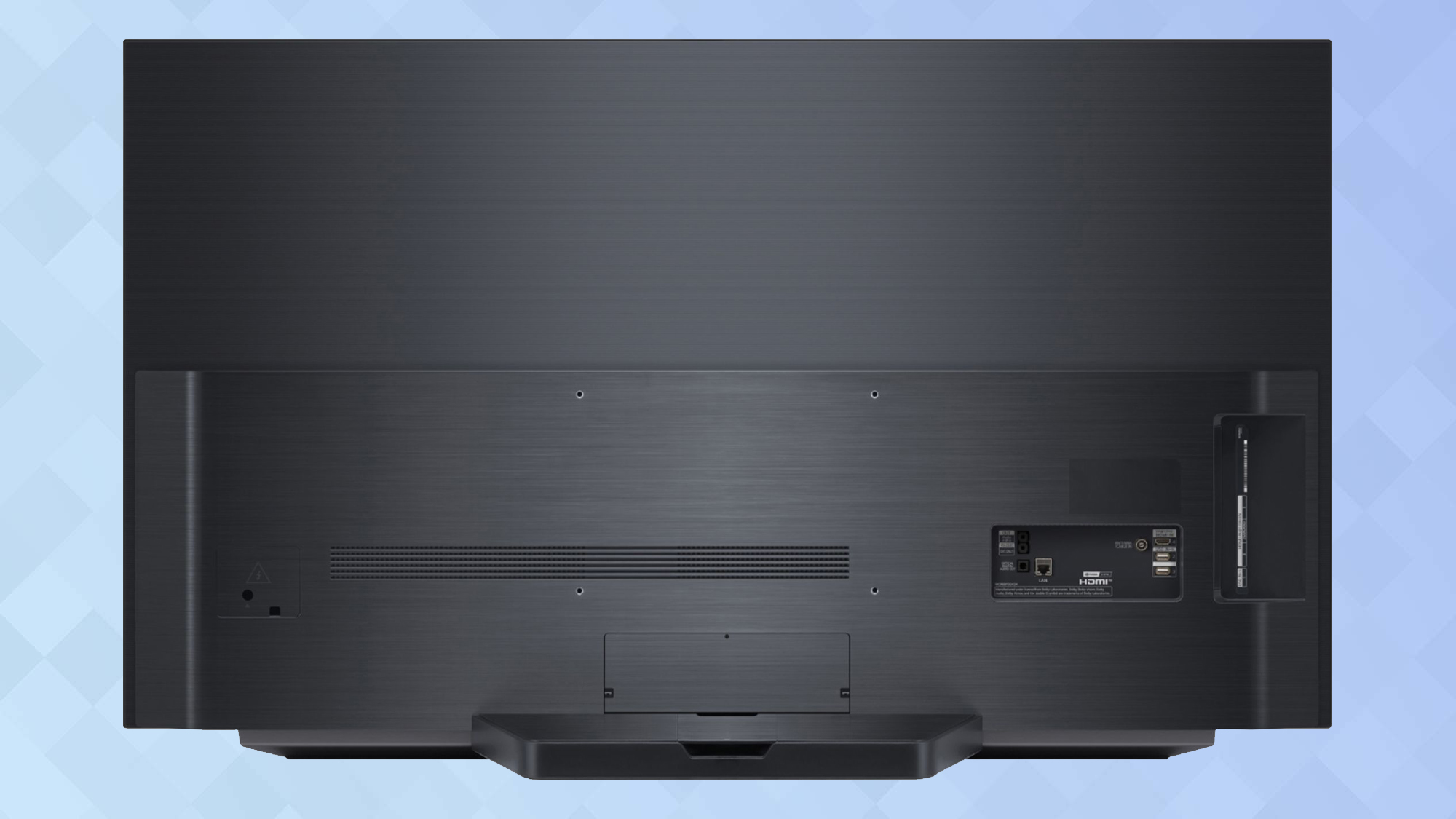
Even on wired systems, Dolby Atmos support delivers immersive, multi-dimensional audio, which you can get through the best soundbars. There is one problem, however. Some users have complained that there's significant audio delay on LG OLED TVs when using Dolby Atmos with certain devices. For example, when gaming on Xbox Series X lip sync can feel off by a good 1-2 seconds, something that becomes grating. We hope that a fix is coming.
LG's AI Sound Pro can also be used to optimize audio for the room and surroundings of the TV, adjusting the sound to better reflect off of nearby furniture and walls for a richer soundscape, even with no additional speakers.
LG C1 OLED: Smart TV features
The LG C1 OLED has great smart TV functions, thanks largely to the improved webOS 6.0. The updated interface has a cleaner look, with multiple rows of apps and content suggestions, closer to the interface used by Google TV than the single ribbon menu of apps that older webOS versions used.
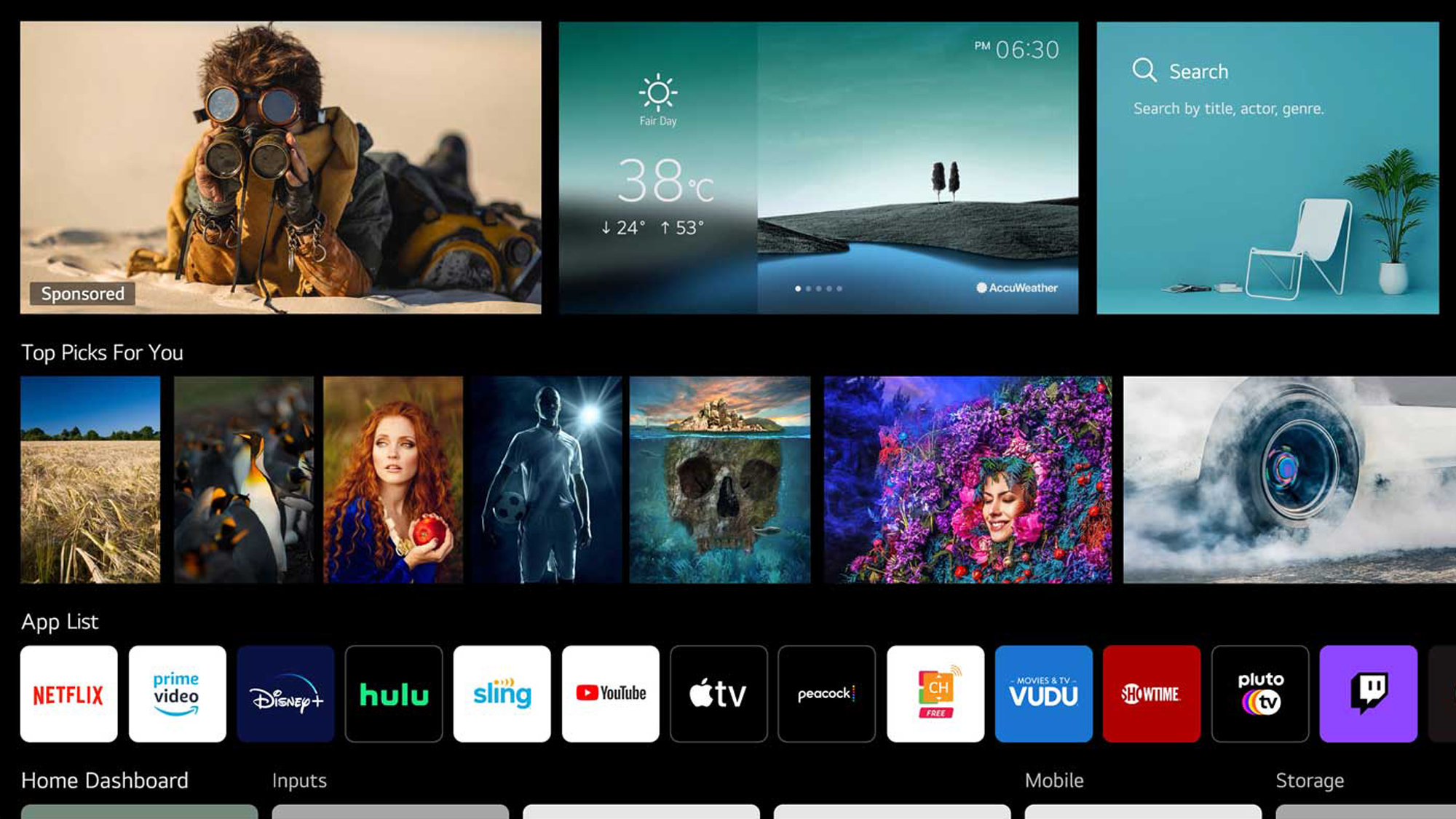
It's smarter in some unusual ways, with features like Sports Alert, which lets you get updates on your favorite sports and individual teams, like start times for events and scores for ongoing matches, even while watching other content.
LG's ThinQ AI combines intuitive content search with both Google Assistant and Amazon Alexa voice assistants, with both available right from the remote.

LG's app selection is also better than it's ever been, with recent additions bringing services like Peloton and HBOmax. The app selection isn't the biggest of any smart TV platform we've seen, but it has most of the apps that people really want – but it's missing a few, like DIscovery+, Philo TV and several popular BBC apps (and even popular options like Apple TV+ have lagged months behind other TVs in getting support) so look up your must-have apps to make sure you can get it on webOS.
One more cool thing for gamers: LG also has superb support for cloud gaming services. With both Google Stadia and Nvidia GeForce Cloud, it's a great gaming TV even if you don't have a game console or PC connected.
LG C1 OLED: Remote control
LG's revamped Magic Remote is just as good as the last time we looked at it, which has a sleeker profile than in years past, making it more comfortable to hold in the hand than its bulbous predecessor. The scrolling click wheel in the center of the remote makes it easy to browse through menus and lists, while the motion controlled cursor on-screen gives you an intuitive way to navigate apps.
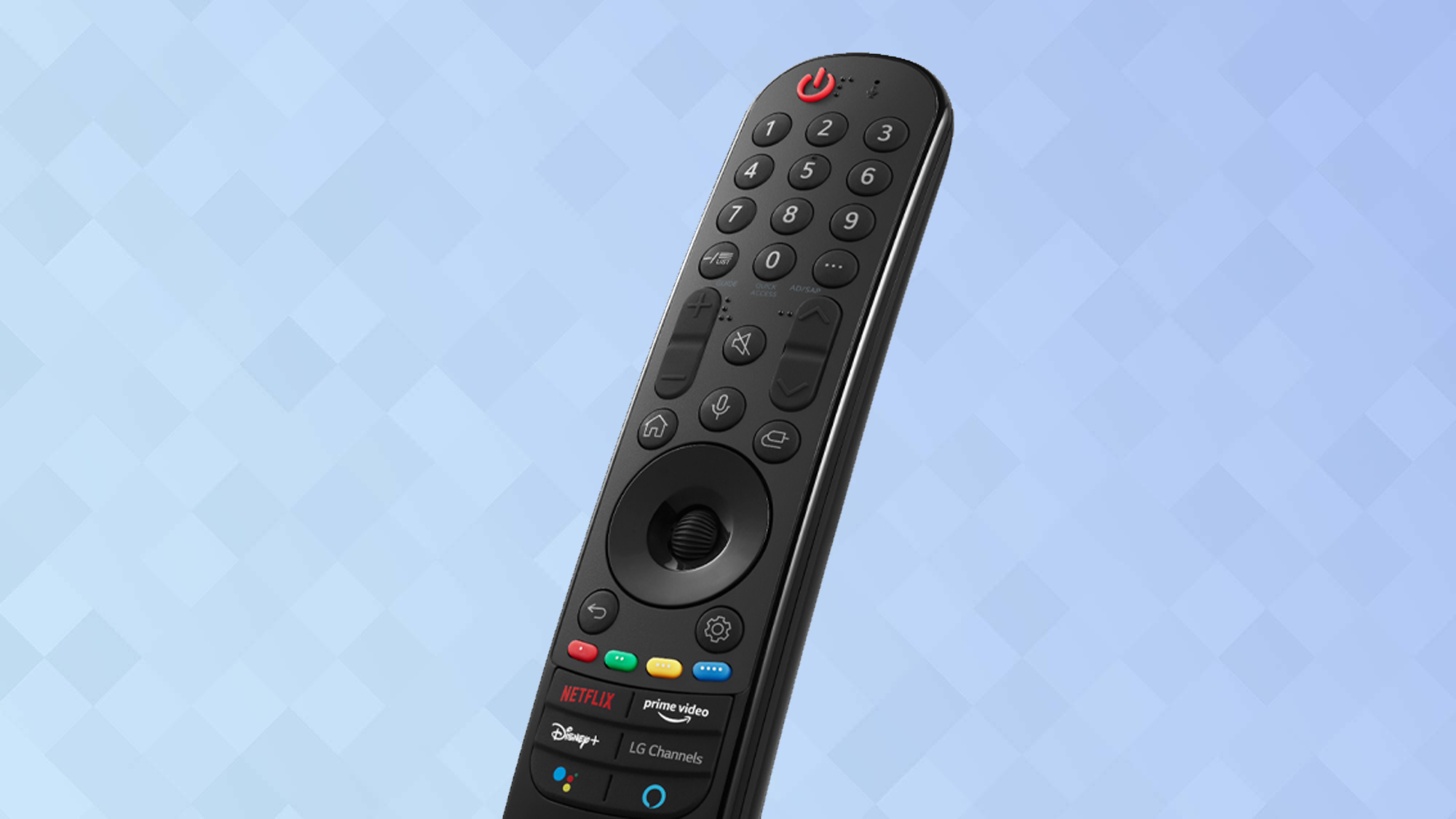
Dedicated app buttons on the remote let you jump right to popular apps, like Netflix, Prime Video, Disney Plus, and LG Channels, which offers a bunch of free content you can enjoy without any kind of sign up or subscription.
The rest of the remote layout is pretty self-explanatory, with number buttons for jumping to specific channels, up and down buttons for adjusting volume and flipping channels, and buttons for opening menus or using both Google Assistant and Amazon Alexa.
LG C1 OLED review: Verdict
The LG C1 OLED is a superb TV, and in many respects, it's close to perfect. The picture quality is fantastic. The gaming performance and features are second to none. The sound quality needs a little tweaking to get it dialed in, but between AI optimization and adjustments for personal preference, it goes from good to great very quickly, and will deliver even better sound when paired with a great soundbar or speakers. LG' webOS is better than it's ever been, and when paired with the improved remote and dual-assistant voice control options, it's a deeply intuitive and powerful smart TV experience.
You'll be hard pressed to find a better looking TV, but other elements, like the smart TV software, we've seen competitors edge slightly ahead. The Sony Bravia XR A80J OLED offers similar premium performance with Google TV (which is the best smart TV platform on the market right now), and the Samsung QN90A Neo QLED TV offers better brightness than OLED can match while going point for point on most features.
But in terms of delivering a great total package, from the basics to the finer touches, the LG C1 OLED is definitely one of the best, and puts it all together at a premium price that matches the value you get. The Samsung and Sony models edge ahead in a few specific areas, but there's no doubt that this is one of the best sets on the market, and the best gaming TV you can buy.
Brian Westover is currently Lead Analyst, PCs and Hardware at PCMag. Until recently, however, he was Senior Editor at Tom's Guide, where he led the site's TV coverage for several years, reviewing scores of sets and writing about everything from 8K to HDR to HDMI 2.1. He also put his computing knowledge to good use by reviewing many PCs and Mac devices, and also led our router and home networking coverage. Prior to joining Tom's Guide, he wrote for TopTenReviews and PCMag.
